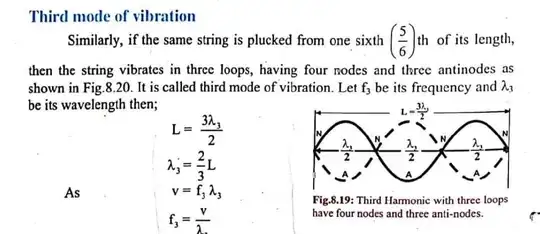I have a question regarding the formation of loops when a string is plucked at different fractional lengths.
In a book I referenced, it is stated that plucking a string at 1/6 of its length produces 3 loops. However, based on other sources I've read, the understanding is different.
From what I've gathered:
Plucking a string at half its length ($L/2$) produces 1 loop.
Plucking at $L/4$ produces 2 loops.
Therefore, for 3 loops, it seems logical that the length should be L/8, following a general formula of $L/2^n$, where $n$ represents the number of loops. For example:
To get 1 loop, $n=1$, so $L/2^1 = L/2$.
To get 2 loops, $n=2$, so $L/2^2 = L/4$.
To get 3 loops, $n=3$, so $L/2^3 = L/8$.
Can someone clarify if this reasoning is correct, or explain why a string plucked at 1/6 of its length would produce 3 loops?
